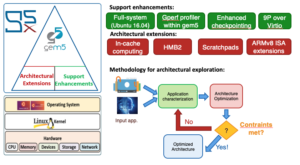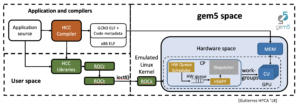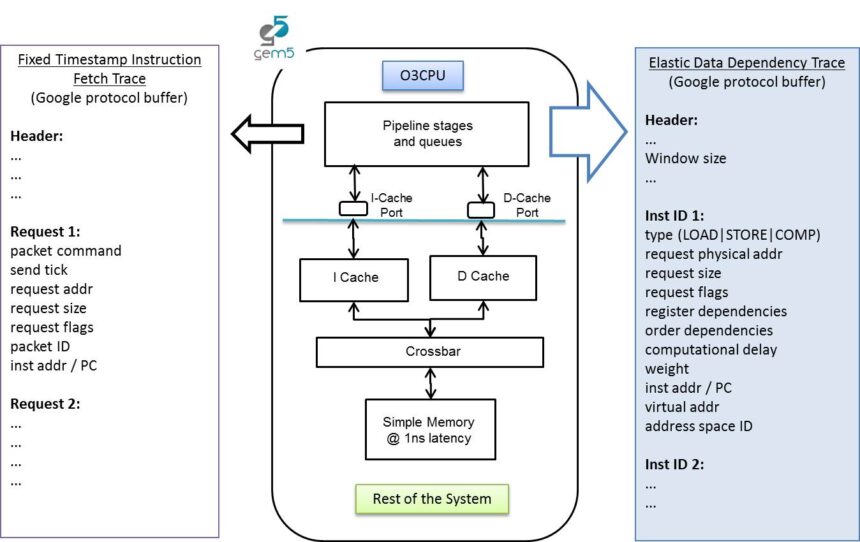If you’re wondering how to use CPT upgrade in gem5, you’re in the right place! CPT, or Checkpointing and Profiling Tools, help you save and manage your simulation states in gem5. This guide will walk you through the basics of using CPT upgrades to make your simulations more efficient and easier to manage.
Using CPT upgrades in gem5 can seem tricky, but it’s actually quite straightforward once you get the hang of it. You’ll learn how to set up and use these tools to improve your simulation process. By the end, you’ll be able to handle your simulations like a pro!
What is CPT in gem5?
Checkpointing and Profiling Tools (CPT) in gem5 are helpful features for saving and managing your simulation states. How to use CPT upgrade in gem5 starts with understanding these tools. CPT allows you to pause simulations and save their state, so you can pick up where you left off without starting from scratch How to Use CPT Upgrade in gem5.
These tools are essential for running long simulations where you need to keep track of different stages. By using CPT, you can manage simulation profiles and save resources. This means you can spend more time analyzing results instead of restarting simulations.
CPT helps you improve your workflow by letting you save snapshots of your simulation at different points. This makes it easy to compare different runs and see how changes affect your results. With CPT, you get more flexibility in how you run and analyze simulations How to Use CPT Upgrade in gem5.
Why Use CPT Upgrade in gem5?
Using CPT upgrades in gem5 offers several benefits that make your simulations more efficient. How to use CPT upgrade in gem5 can greatly improve your workflow. Upgrades to CPT tools help manage large simulations and reduce the time needed to analyze results.
With CPT upgrades, you can save your simulation state at various stages. This makes it easier to track progress and make adjustments without losing your work. Upgraded CPT tools help you handle more complex simulations and get better results.
Another reason to use CPT upgrades is to improve your simulation’s performance. Upgraded tools can optimize how simulations are saved and restored, which means less waiting and more doing. This is especially useful for long or resource-intensive simulations How to Use CPT Upgrade in gem5.
Getting Started: How to Use CPT Upgrade in gem5
Getting started with CPT upgrades in gem5 involves a few key steps. How to use CPT upgrade in gem5 begins with setting up your environment. You will need to install the latest gem5 version and ensure CPT tools are properly configured.
First, you should update your gem5 installation to include the latest CPT features. This may involve downloading and installing new files or adjusting settings. Once updated, you can start exploring the new capabilities offered by CPT upgrades How to Use CPT Upgrade in gem5.
Next, configure your simulation to use CPT tools. This means setting up checkpoints and profiles so that your simulations can be saved and managed effectively. You will need to follow specific instructions to ensure everything works correctly.
Step-by-Step Guide to Using CPT Upgrade in gem5

A step-by-step guide makes learning how to use CPT upgrade in gem5 easier. Start by installing the latest gem5 version with CPT upgrades. This usually involves downloading new software and following installation instructions provided by gem5.
How to Use CPT Upgrade in gem5 Next, configure your simulation environment. This means setting up parameters and options related to CPT tools. You’ll need to adjust settings for saving and restoring simulation states to match your needs.
After configuration, test the CPT tools by running a few sample simulations. Use these tests to check if checkpoints and profiles are being created and managed correctly. This helps ensure that the upgrades are working as expected.
How to Install CPT Upgrade for gem5
Installing CPT upgrades for gem5 is a straightforward process. How to use CPT upgrade in gem5 begins with obtaining the latest version of gem5 that includes CPT tools. You can usually download this from the gem5 website or through a package manager.
Once downloaded, follow the installation instructions carefully. This typically involves unpacking files and running installation scripts. Make sure to check for any dependencies that need to be installed as well.
How to Use CPT Upgrade in gem5 After installation, verify that the CPT tools are included in your gem5 setup. You can do this by checking the gem5 version and ensuring that CPT features are listed. This step confirms that the installation was successful.
Setting Up CPT in gem5: A Beginner’s Guide
Setting up CPT in gem5 can seem challenging at first, but it’s quite manageable with the right steps. How to use CPT upgrade in gem5 involves configuring settings to enable checkpointing and profiling tools in your simulation environment.
Begin by accessing the gem5 configuration files. You’ll need to adjust these files to enable CPT features. Look for options related to checkpoints and profiles and set them according to your needs.
Next, configure your simulation scripts to use CPT tools. This might involve adding specific commands or parameters to your simulation scripts. Ensure that checkpoints and profiles are saved in the desired locations.
Tips for Using CPT Upgrade in gem5
Using CPT upgrades in gem5 can be simplified with a few helpful tips. How to use CPT upgrade in gem5 involves making the most of the new features and ensuring they fit your simulation needs.
First, make sure to regularly save checkpoints during long simulations. This helps you avoid losing progress and allows you to resume simulations from different points. Regularly saved checkpoints also make it easier to analyze results.
Second, use profiling tools to monitor simulation performance. This helps you identify any bottlenecks or issues that might be affecting your results. Profiling tools provide valuable insights into how simulations are running.
Third, keep your gem5 installation updated to benefit from the latest CPT features. Upgrading gem5 ensures you have access to the newest tools and improvements, making your work more efficient.
How to Save Simulation States with CPT Upgrade in gem5
Saving simulation states is a crucial part of how to use CPT upgrade in gem5. Checkpointing tools allow you to pause and save your simulation at different points. This means you can resume from these points without starting over.
To save a simulation state, first ensure that CPT tools are enabled in your gem5 setup. You will need to configure settings to specify when and where checkpoints should be created. This usually involves adjusting configuration files.
Next, during your simulation, use commands or scripts to trigger checkpoint creation. This allows you to save the current state at specific intervals or events. These saved states can be restored later as needed.
Managing Simulation Profiles with CPT Upgrade in gem5
Managing simulation profiles is an important part of how to use CPT upgrade in gem5. Profiles help you track different aspects of your simulation and manage how results are collected and analyzed.
Start by configuring profile settings in gem5. This involves specifying what data should be collected and how it should be organized. Profiles can include performance metrics, resource usage, and other relevant information.
Next, use profiling tools to collect data during simulations. These tools provide insights into how your simulation is performing and help you identify areas for improvement. Managing profiles allows you to keep track of different runs and compare results.
Troubleshooting Common Issues with CPT Upgrade in gem5
Troubleshooting is a key skill when learning how to use CPT upgrade in gem5. Common issues can arise when setting up or using CPT tools, but most problems can be resolved with some simple steps.
First, check for common setup errors, such as missing files or incorrect configurations. Ensure that all necessary components are installed and configured properly. Refer to gem5 documentation for guidance on setup and configuration.
Second, if you encounter issues with checkpoint creation or restoration, verify that your settings are correct. Make sure that checkpoints are being saved in the right locations and that there are no conflicts with file paths or permissions.
How to Optimize Simulations Using CPT Upgrade in gem5
Optimizing simulations with CPT upgrades in gem5 can enhance performance and efficiency. How to use CPT upgrade in gem5 involves configuring tools to make your simulations run smoother and faster.
Start by adjusting checkpoint intervals based on your simulation needs. This helps balance between saving too frequently and not often enough. Finding the right interval ensures you capture useful data without slowing down your simulation.
Next, use profiling tools to identify performance bottlenecks. Profiling can reveal areas where improvements can be made, such as optimizing resource usage or reducing wait times. Addressing these bottlenecks can lead to more efficient simulations.
How to Load and Restore Checkpoints in gem5
Loading and restoring checkpoints is a vital part of how to use CPT upgrade in gem5. This process allows you to pick up simulations from where you left off, rather than starting over.
First, ensure that you have saved checkpoints from your previous simulations. Checkpoints should be saved in a location that is easy to access and manage. Make sure you know where your checkpoints are stored.
To restore a checkpoint, use gem5 commands or scripts to load the saved state. This involves specifying the checkpoint file and configuring any settings needed for restoration. Follow gem5 documentation for detailed instructions.
Best Practices for CPT Upgrade in gem5
Following best practices can improve your experience with how to use CPT upgrade in gem5. These practices help ensure that your simulations are efficient, accurate, and manageable.
First, regularly save checkpoints during long simulations. This reduces the risk of losing progress and allows you to resume from different points. Consistent checkpointing helps you manage complex simulations more effectively.
Second, use profiling tools to monitor simulation performance. Profiling provides insights into how your simulation is running and highlights areas for improvement. This data can help you optimize your setup and achieve better results.
Understanding CPT Profiles in gem5
Understanding CPT profiles is important for how to use CPT upgrade in gem5. Profiles help you manage and analyze different aspects of your simulation, providing valuable insights into performance and resource usage.
Begin by configuring profile settings to collect relevant data. Profiles can include metrics such as execution time, memory usage, and other performance indicators. Set up your profiles to capture the information you need for analysis.
Next, use profiling tools to generate and review profile data. This data can help you identify trends, detect issues, and make informed decisions about your simulations. Properly managed profiles provide a clear view of your simulation’s performance.
How to Upgrade Your gem5 Simulation with CPT Tools
Upgrading your gem5 simulation with CPT tools involves incorporating the latest features and improvements. How to use CPT upgrade in gem5 focuses on enhancing your simulation setup with new capabilities.
Start by ensuring that you have the latest version of gem5 that includes CPT upgrades. Download and install any updates to your gem5 setup. This ensures you have access to the newest features and enhancements.
Next, configure your simulation environment to use the upgraded CPT tools. Adjust settings and parameters to incorporate new features and improvements. This might involve updating configuration files or scripts.
How to Use CPT Upgrade in gem5 for Better Performance
Using CPT upgrades in gem5 can enhance simulation performance. How to use CPT upgrade in gem5 focuses on optimizing your setup to run simulations more efficiently and effectively.
First, configure checkpoint intervals to balance performance and data capture. Adjusting these intervals helps you avoid excessive saving that can slow down your simulation. Find a balance that suits your needs.
Second, use profiling tools to monitor and optimize simulation performance. Profiling helps you identify any issues that may affect your results. Addressing these issues improves overall simulation efficiency.
Exploring Advanced Features of CPT Upgrade in gem5
Exploring advanced features of CPT upgrades in gem5 can unlock new possibilities for your simulations. How to use CPT upgrade in gem5 involves taking advantage of these features to enhance your work.
Start by reviewing the latest documentation and updates for CPT tools. This helps you understand new features and how they can be used in your simulations. Look for advanced options that offer additional capabilities.
Next, experiment with advanced CPT features in your simulations. Test new tools and settings to see how they impact performance and data management. This hands-on experience helps you learn how to use these features effectively.
How to Automate Checkpoint Management in gem5
Automating checkpoint management in gem5 can streamline your simulation process. How to use CPT upgrade in gem5 includes setting up automation to handle checkpoints efficiently.
Begin by configuring scripts or tools to automate checkpoint creation. This might involve setting up schedules or triggers that automatically save simulation states at specific intervals or events.
Next, use automation tools to manage checkpoint storage and organization. This ensures that checkpoints are saved in the right locations and are easy to access when needed. Automation helps you maintain a tidy and organized simulation environment.
Real-Life Examples of Using CPT Upgrade in gem5

Real-life examples show how how to use CPT upgrade in gem5 can benefit your simulations. These examples illustrate practical applications and help you understand the value of CPT upgrades.
One example is using CPT upgrades to manage large-scale simulations in research projects. By saving and restoring states, researchers can handle complex simulations more effectively and analyze results from different points.
Another example is optimizing simulation workflows in industrial applications. Companies can use CPT tools to track performance and manage simulation profiles, leading to more efficient processes and better results.
Future Trends: How CPT Upgrade Will Evolve in gem5
Looking at future trends in how to use CPT upgrade in gem5 can provide insights into upcoming developments. As gem5 evolves, CPT tools will also see improvements and new features.
One trend is the integration of more advanced profiling and checkpointing capabilities. Future upgrades may include enhanced tools for managing large-scale simulations and analyzing detailed performance metrics.
Another trend is increased automation and ease of use. Future CPT upgrades may offer more user-friendly options and automated processes to simplify checkpoint management and profiling.
Conclusion
In conclusion, how to use CPT upgrade in gem5 offers significant advantages for managing and optimizing your simulations. By understanding and implementing checkpointing and profiling tools, you can enhance your simulation efficiency and effectiveness. The CPT upgrades provide a range of new features and improvements that make it easier to save, restore, and analyze simulation states.
Using CPT upgrades helps streamline your workflow, reduce downtime, and improve performance. With features like automated checkpoint management and advanced profiling, you can handle complex simulations more effectively and gain deeper insights into your results. Regularly updating your gem5 setup ensures you stay current with the latest advancements and best practices.







